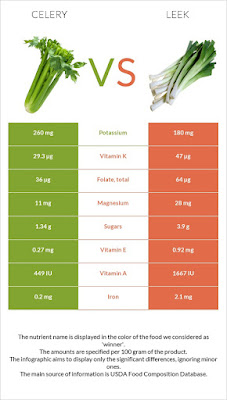It has two kinds of fat - omega-3 and oleic. Vitamin A is good source of vitamin A. That is why it is included in avocados, canned sardines and fish. In contrast, vitamin C which is a stronger type of antioxidant found in citrus fruits and vegetables, is found in broccoli, cauliflower, green beans and peppers.
Researchers have found that this vegetable has more than 300 vitamins, minerals and nutrients. It is a good dietary fiber. Since it is rich in potassium, it helps keep your urinary tract and heart disease free. Low blood pressure and cholesterol are also reduced. It lowers bad cholesterol or bad fats in your blood.
According to a research published in the May-June 2021 issues of "Food and Brand Identity", the beta-carotene present in celery is responsible for the color. The study published in the May-June 2021 issues of "Food and Brand Identity" showed that beta-carotene from vegetables is responsible for carrots' orange color. The same study published in the "American Journal of Nutrition" showed that dietary fiber is responsible for spinach's yellow color. Based on these studies, the beta-carotene present in celery is beneficial to our body.
Folate is important for cell division and reproduction. It helps with the absorption of iron in our body. It reduces homocysteine levels and helps prevent heart diseases and strokes. A study published in "The American Journal of Clinical Nutrition" found that women who ate at least six servings of fruits and veggies per day had lower levels of homocysteine compared to women who didn't eat fruits and veggies. They even found a reduction in the risk of developing coronary artery disease.
There are plenty of nutrition facts about celery that we can learn from this small vegetable. First, it has a low-fat content, making it an ideal food choice to consume after weight loss programs. Its fiber content is also high, making it an ideal food to add to a salad or to a diet. It has just the right amount of sodium, making it safe to include in our daily diet. It's good for those who have kidney or liver diseases because of its potassium and folate contents.
Celery is a great choice to increase your antioxidant intake as well. Some studies show that eating a serving of the vegetable per day may help reduce the risk of developing cardiovascular diseases like heart attacks and strokes. It may also help prevent atherosclerosis, a condition that develops when cholesterol clogs up the arteries. While some believe that consuming the vegetable is only for heart health purposes, recent studies show that it may also protect against prostate cancer. As a matter of fact, one study found that men who ate two or more portions of the vegetable daily were less likely to develop prostate cancer. This may help to explain why celery is so popular among male athletes.
In one study, rats that were injected with cholesterol showed no significant increases in triglycerides. But they did have lower blood pressure levels than the control group. Also, the rats in the control group showed no significant increase in the levels of total LDL or good cholesterol (LDL). But, in the group that was injected with cholesterol having higher amounts of HDL (good cholesterol) they showed a significant decrease in blood pressure. These results indicate that consuming celery may be a good way to improve blood pressure and may lower LDL cholesterol levels too.
